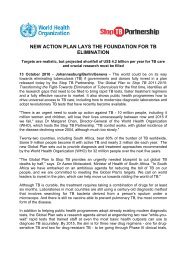Concept note on national stop TB partnership [.pdf]
Concept note on national stop TB partnership [.pdf]
Concept note on national stop TB partnership [.pdf]
Create successful ePaper yourself
Turn your PDF publications into a flip-book with our unique Google optimized e-Paper software.
- It aims at strengthening the preventi<strong>on</strong>, care and c<strong>on</strong>trol of tuberculosis in a given country<br />
towards the targets of the Global Plan to Stop <strong>TB</strong> 1 , in close collaborati<strong>on</strong> with the nati<strong>on</strong>al<br />
<strong>TB</strong> c<strong>on</strong>trol programme (NTP) and with the support, if needed, of the Global Stop <strong>TB</strong><br />
Partnership Secretariat. Civil society/private/corporate sector actors will be equal and<br />
independent partners, and work within the framework of the nati<strong>on</strong>al <strong>TB</strong> plan.<br />
- A nati<strong>on</strong>al <strong>stop</strong> <strong>TB</strong> <strong>partnership</strong> can c<strong>on</strong>tribute to the implementati<strong>on</strong> of the nati<strong>on</strong>al plan<br />
to c<strong>on</strong>trol <strong>TB</strong> by harnessing the c<strong>on</strong>tributi<strong>on</strong> of all relevant stakeholders. For this reas<strong>on</strong>,<br />
its main focus is decided by its partners <strong>on</strong> a case by case basis and it can vary<br />
depending <strong>on</strong> the country c<strong>on</strong>text. Current examples range from the Canadian<br />
<strong>partnership</strong> focusing <strong>on</strong> advocacy and resource mobilizati<strong>on</strong> to Stop <strong>TB</strong> Swaziland<br />
focusing <strong>on</strong> coordinati<strong>on</strong> of service delivery<br />
3. Why to establish a nati<strong>on</strong>al <strong>stop</strong> <strong>TB</strong> <strong>partnership</strong> 2 ?<br />
The operati<strong>on</strong>al challenges of <strong>TB</strong> c<strong>on</strong>trol and the social aspects of the disease demand a<br />
joint effort of instituti<strong>on</strong>s, civil society and private/corporate sectors. While governments are<br />
resp<strong>on</strong>sible for ensuring services reach the people in need, different actors (civil society and<br />
private/corporate sector) are often involved in <strong>TB</strong> preventi<strong>on</strong>, care and c<strong>on</strong>trol. In this<br />
situati<strong>on</strong>, governments could recognize and support as part of the public system other actors<br />
that instituti<strong>on</strong>ally do not bel<strong>on</strong>g to the state ("public functi<strong>on</strong> of private initiative")..<br />
The benefits of establishing a nati<strong>on</strong>al <strong>stop</strong> <strong>TB</strong> <strong>partnership</strong> may vary and occur at different<br />
stages or simultaneously. They include:<br />
1. Coordinati<strong>on</strong> and a comm<strong>on</strong> strategy. Partners agree to work towards a visi<strong>on</strong> and the<br />
achievement of a comm<strong>on</strong> goal. The <strong>partnership</strong> offers a forum where partners exchange<br />
informati<strong>on</strong>, discuss and negotiate <strong>on</strong>e shared goal and a corresp<strong>on</strong>dent shared strategy.<br />
In this way, <strong>partnership</strong>s facilitate the coordinati<strong>on</strong> and synergy of work usually d<strong>on</strong>e in<br />
parallel by different organizati<strong>on</strong>s and, therefore, avoid duplicati<strong>on</strong> of effort and waste of<br />
time and resources.<br />
2. Multi-sectoral participati<strong>on</strong>. Partners from different sectors of society (public,<br />
private/corporate, civil society) and with different backgrounds (medical doctors, social<br />
scientists, community workers, business managers, etc.) are involved. Each partner<br />
could c<strong>on</strong>tribute to the <strong>partnership</strong> and the achievement of the comm<strong>on</strong> goal according to<br />
its specific role and competence. In this way, <strong>partnership</strong>s introduce a new and<br />
innovative way of working across different sectors of the society, including a need to<br />
discuss and compare different approaches and find a c<strong>on</strong>sensus <strong>on</strong> the most appropriate<br />
<strong>on</strong>e. Within a <strong>partnership</strong>, partners would reciprocally respect their identity, and<br />
competiti<strong>on</strong> would give way to efforts to maximize synergies and complementarities.<br />
3. Increased resources. Partners bring to the <strong>partnership</strong> the full range of technical, human,<br />
knowledge, physical and network resources found within all sectors. In this way,<br />
<strong>partnership</strong>s go bey<strong>on</strong>d the c<strong>on</strong>cepti<strong>on</strong> of financial resources as sole type of resources.<br />
1 Stop <strong>TB</strong> Partnership and World Health Organizati<strong>on</strong>. Global Plan to Stop <strong>TB</strong> 2006-2015. Geneva,<br />
World Health Organizati<strong>on</strong>, 2006 (WHO/HTM/S<strong>TB</strong>/2006.35) available at<br />
http://www.<strong>stop</strong>tb.org/globalplan/.<br />
2 For more informati<strong>on</strong> <strong>on</strong> the rati<strong>on</strong>ale and benefits of nati<strong>on</strong>al <strong>partnership</strong>s: The power of<br />
<strong>partnership</strong>s. Geneva, World Health Organizati<strong>on</strong>, 2003 (WHO/HTM/S<strong>TB</strong>/2003.24) available at<br />
http://www.<strong>stop</strong>tb.org/resource_center/assets/documents/WHO-HTM-S<strong>TB</strong>-2003.24-PocketG-<br />
2colorsfin.<strong>pdf</strong>.<br />
2


![Concept note on national stop TB partnership [.pdf]](https://img.yumpu.com/26788741/2/500x640/concept-note-on-national-stop-tb-partnership-pdf.jpg)




![Global Drug Facility Annual Report 2011 [.pdf] - Stop TB Partnership](https://img.yumpu.com/26788745/1/184x260/global-drug-facility-annual-report-2011-pdf-stop-tb-partnership.jpg?quality=85)





![2005 and Challenges for 2006 - 2015 [.pdf] - Stop TB Partnership](https://img.yumpu.com/26788674/1/190x245/2005-and-challenges-for-2006-2015-pdf-stop-tb-partnership.jpg?quality=85)
![Brochure (French) [.pdf] - Stop TB Partnership](https://img.yumpu.com/17234792/1/190x91/brochure-french-pdf-stop-tb-partnership.jpg?quality=85)

